Google Drive
June - september 2018
Objective
To uncover interesting types of users that live within the Drive landscape in order to broaden the team’s view on enterprise end-user types and how Drive fits into their work ecosystem. By doing so, stakeholders will be able to evaluate and modify Drive’s roadmap to better align with user goals.
My Approach
Reviewed existing research
Created a research plan, script, & screener
Recruited for & conducted dyad interviews
Analysis & synthesis of notes
Methodology
Method: Dyad Interviews
Purpose: By conducting dyad interviews, we can better understand company dynamics, the ecosystem in which the users work in, and the interaction/ collaboration between users within a company. This will help uncover the company’s culture (i.e. top-down vs. bottom up) and its’ effects or non-effects on Drive usage.
Structure: 75 minute, remote interviews with enterprise users and a colleague — 9 pairs, 18 total participants
Recruiting Process
Created a screener to help screen for end-users that would fit in six hypothesized user types based on analysis of existing research
Worked with a recruiter to select participants to recruit from a shortlist
Implemented snowball recruiting where the selected participants found a co-worker to do the interview with and I sent out a condensed screener to the selected co-worker
Recruited participants came from a range of industries, company sizes, and roles
Collaborated with a recruiter to review a shortlist and assessed which participants to interview
Analysis & Synthesis
Transcribed interview notes onto sticky-notes
Grouped notes by the initial six defined end-user types and developed new themes throughout the process
Defined pain points and opportunity areas (How Might We...”)
Shared research findings with four designers and with other UXRs on the Drive team
While conducting interviews, I put together a daily takeaways deck that summarized initial research findings and interesting quotes from interviews conducted that day in order to keep stakeholders informed throughout the process
Synthesizing process
Collaborating and sharing my findings with a UX Designer
Sharing a draft of my final presentation to one of my stakeholders, Drive’s UXR lead
Responses from the daily takeaways deck
Final Deliverable
After multiple iterations. I created a findings deck that was shared across G-Suite teams and presented to the broader Google Drive team, which included other UX Researches, UX Designers, UXR lead, Drive UX lead, and Drive product managers. The report included 2 user-types and 4 user sub-types, which we called user spotlights. These spotlights highlighted end-users that lived in each user types, but is not an exhaustive list of all the end-user types. Below is a sample of a few slides from the final deck with proprietary information crossed out.










Impact
The findings from this report was used to plan and prioritize for 2019 project milestones.
Findings will be used to contribute to G-Suite cross apps persona/segmentation creation
UX Researchers from the Drive team plan to explore scenario creation and quant research to validate findings
Challenges & Lessons Learned
Always Conduct Stakeholder Interviews & Have a Good Understanding of Project GoalsThis was one of the biggest lessons I learned and allowed me to have a successful project that created a lasting impact on the team. When conducting stakeholder interviews, there were conflicting viewpoints on where the focus of my project should be; some ideas were out of scope for the given timeframe and others had a negative experience with personas. After getting a better understanding of each stakeholder’s viewpoints, I decided to pivot and develop user types and spotlights, which aimed to highlight interesting end-users that would hit all product areas. When this change was made, I created a presentation to present to stakeholders how I was going to move forward with my project in order to gain stakeholder buy-in and ensure there was transparency throughout the process.
Collaboration is Key! Through my internship at Google, I learned the value of seeking continuous feedback. By having other UX Researchers review my research plan and findings deck, I was able to discover any holes and rephrase anything that was unclear. Furthermore, by understanding what other designers on my team were working on, I was able to share with them findings that related to their project and help guide them with ideas for consideration.
Be Transparent
By creating a daily findings deck, stakeholders and other people on my team were aware of my progress and kept research at the top of mind for them. This helped people stay involved throughout my process and ensured that my findings weren’t being lost. Also, by sharing my findings with designers as I go, it allowed them to iterate on their designs and either validate what they were creating or gave them new ideas to think about.
Being Clear & ConciseIt took many iterations to get my final report to where it is today. With 12 hours worth of interviews to synthesize from 18 participants, it was important for me to gather the most important information and present it in a way that would resonate with stakeholders and can be easily referenced during discussions. By seeking feedback from my team and continuous iteration, I was able to create a report that was quick to consume and memorable.
Read my blog posts to learn about what it’s like working at Google and my biggest takeaways from my internship!







